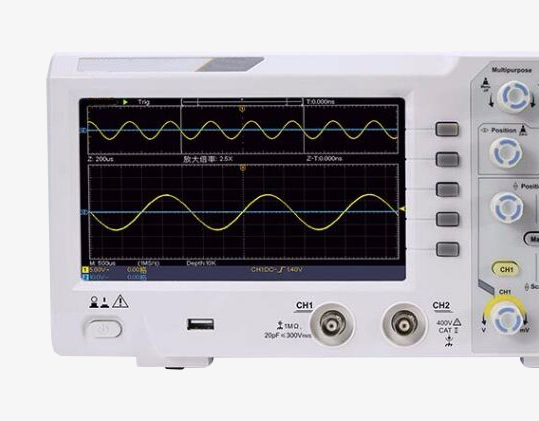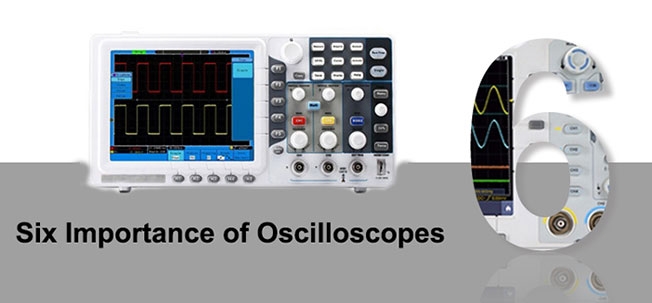Oscilloscopes, as the right hand of engineers, scientists, and technicians, help to observe, measure, and analyze all kinds of electrical signals, providing important information that helps to solve problems, improve designs, and ensure the reliability of systems. sisco store will show you the importance of oscilloscopes as well as their future prospects.
Introduction to Oscilloscopes
An oscilloscope, also known as an oscilloscope, is an electronic measuring instrument used to observe, measure, and analyze the waveform, amplitude, frequency, phase, and other characteristics of electrical signals. Oscilloscopes display voltage versus time, usually in the form of a graphic representation of the waveform on a screen. Oscilloscopes are commonly used in electronic circuit design, troubleshooting, communications, medicine, physics, and engineering.
The Importance of Oscilloscopes
Electronic Circuit Design and Troubleshooting
- Oscilloscopes are indispensable tools in electronic circuit design and manufacturing. Oscilloscopes can be used to observe signal waveforms in electronic circuits to help engineers evaluate circuit performance as well as detect faults, can help engineers observe signal waveforms in circuits to evaluate their performance, stability, and response. With oscilloscopes, engineers can measure the amplitude, frequency, phase difference, and other characteristics of signals to ensure that the design is sound. In addition, oscilloscopes can be used for troubleshooting to help identify problems in circuits, thereby improving productivity and product quality.

Communication Engineering
- In communications engineering, oscilloscopes are used to analyze and debug a variety of signals, both analog and digital. Signals in a communication system need to be transmitted accurately and reliably, or they may lead to communication failures or data loss. Oscilloscopes help engineers detect and correct problems in signals, helping to ensure the stability and performance of communication systems.
Medical Field
- Medical device manufacturers use oscilloscopes to monitor and analyze biological signals such as electrocardiograms (ECG) and electroencephalograms (EEG). These biosignals are critical for diagnosing and monitoring a patient's health. With oscilloscopes, medical professionals can observe and analyze these biological signals to ensure accurate diagnosis and treatment.
Physics Research
- In physics research, oscilloscopes are used to study a variety of waveforms such as sound waves, light waves, and microwaves. Physicists use oscilloscopes to observe these waveforms to study the fundamental principles of nature. Best oscilloscopes provide them with critical tools that play a key role in laboratory research, helping scientists to understand the fundamentals of nature and explore various physical phenomena.
Education
- Oscilloscopes are widely used in education to help students understand the basic concepts of electronics and signal processing. With oscilloscopes, students can personally observe and experiment with various signal waveforms to deepen their understanding of the principles of electronics, providing learners with the opportunity to observe and experiment.

Engineering Projects
- Oscilloscopes are commonly used in engineering projects to verify and test electronic components, control systems, and sensors. These projects require reliable data to assess system performance and stability. Oscilloscopes provide real-time data to help engineers ensure that projects are progressing as planned and at the desired level of performance.
Future Prospects for Oscilloscopes
- Technological Advances: Oscilloscopes will continue to improve in performance and functionality as technology continues to evolve. High-resolution, high-bandwidth, high-sample-rate, and multi-channel oscilloscopes will become more common to meet the growing demand.
- Automation and Intelligence: Oscilloscopes will be more integrated with automation and intelligent systems to provide a more user-friendly experience. Automated analysis and diagnostic capabilities will help simplify engineering tasks and troubleshooting.
- Wireless Connectivity: Wireless oscilloscopes will become more common, allowing users to remotely access and control oscilloscopes over wireless networks. This will play an important role in remote monitoring and collaborative engineering projects.
- Research and Education: Oscilloscopes will continue to play a key role in research and education. Universities and research organizations will continue to invest in modern oscilloscopes to support innovative research.
- Emerging Areas: As emerging areas develop, such as quantum computing, biomedical engineering, and the Internet of Things, oscilloscopes will play a key role in new applications.
- Environmental and Sustainability: Oscilloscope manufacturers will continue to focus on environmental protection and sustainability by adopting greener materials and production processes.
Oscilloscopes help engineers, scientists, and technicians observe and measure a wide range of electrical signals, providing critical information that helps solve problems, improve designs, ensure system reliability, and in turn advance the fields of science and engineering. The importance of oscilloscopes cannot be overlooked. Oscilloscopes are the cornerstone of modern science and technology, providing critical support for a wide variety of applications. As technology continues to evolve, oscilloscopes will continue to improve in performance and functionality, offering even more possibilities for future scientific research and engineering projects.

